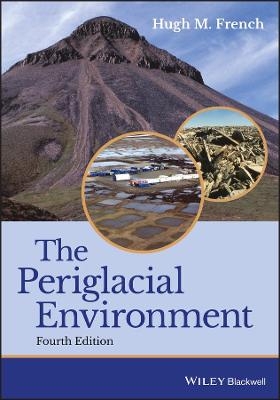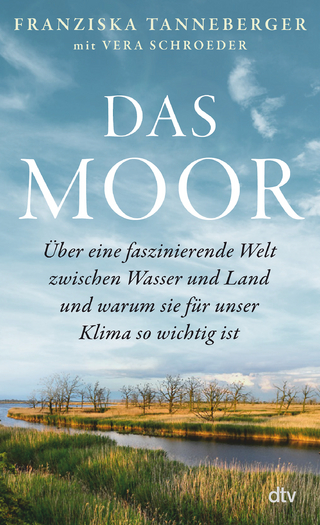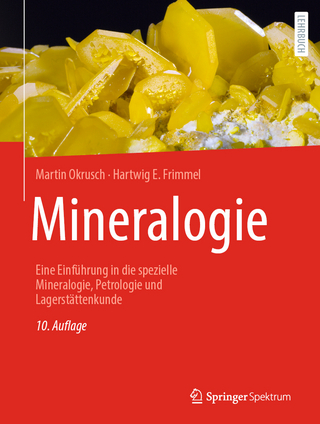
The Periglacial Environment
Wiley-Blackwell (Verlag)
978-1-119-13278-3 (ISBN)
The Periglacial Environment, Fourth Edition, is an authoritative overview of the world’s cold, non-glacial environments. First published in 1976 and subsequently revised in 1996 and 2007, the text has been the international standard for nearly 40 years.
The Fourth Edition continues to be a personal interpretation of the frost-induced conditions, geomorphic processes and landforms that characterize periglacial environments. Part One discusses the periglacial concept and describes the typical climates and ecosystems that are involved. Part Two describes the geocryology (permafrost science) associated with frozen ground. Part Three outlines the weathering and geomorphic processes associated with cold-climate conditions. Part Four provides insight into the periglacial environments of the Quaternary, especially the Late Pleistocene. Part Five describes some of the problems associated with human occupancy in regions that experience frozen ground and cold-climate conditions.
Extensively revised and updated
Written by an expert with over 50 years of field research
Draws upon the author’s personal experience from Northern Canada, Alaska, Siberia, Tibet, Antarctica, Svalbard, Scandinavia, southern South America, Western Europe and eastern North America
This book is an invaluable reference for advanced undergraduates in geography, geology, earth sciences and environmental sciences programs, and to resource managers and geotechnical engineers interested in cold regions.
HUGH M. FRENCH is now Professor Emeritus, University of Ottawa, and an Adjunct Professor, University of Victoria. He lives on southern Vancouver Island, British Columbia, Canada.
Preface to Fourth Edition xv
Preface to Third Edition xvii
Preface to Second Edition xix
Preface to First Edition xxi
Acknowledgments xxiii
Part I The Periglacial Domain 1
1 Introduction 3
1.1 The Periglacial Concept 3
1.2 Diagnostic Criteria 4
1.3 Periglacial Environments 5
1.4 The Periglacial Domain 6
1.5 The Periglacial Domain and the Cryosphere 9
1.6 Disciplinary Considerations 10
1.6.1 The Growth of Geocryology 10
1.6.2 The Challenge of Quaternary Science 11
1.6.3 Periglacial Geomorphology or Cold-Region Geomorphology? 12
1.7 Societal Considerations 12
1.8 The Growth of Periglacial Knowledge 13
2 Periglacial Climates 17
2.1 Boundary Conditions 17
2.2 Cold Deserts 17
2.3 Regional Climates 19
2.3.1 High Arctic Climates 22
2.3.2 Continental Climates 24
2.3.3 Alpine Climates 24
2.3.4 Montane Climates 25
2.3.5 Climates of Low Annual Temperature Range 25
2.3.6 Antarctica: A Special Case 26
2.4 Snow and Ice 26
2.5 Wind 28
2.6 Ground Climates 28
2.6.1 The ‘n’-Factor 28
2.6.2 TheThermal Offset 29
2.6.3 The Ground Temperature Regime 31
2.7 Periglacial Climates and Global Climate Change 35
2.7.1 Basic Facts 37
2.7.2 Why Climate–Cryosphere Interactions Accelerate ClimateWarming 38
3 Periglacial Ecosystems 41
3.1 General Statement 41
3.2 Biogeographic Zonation and Major Vegetation Types 41
3.3 Adaptations to Cold, Snow,Wind and Aridity 44
3.4 The Effect of Vegetation 44
3.5 The Polar Deserts 47
3.5.1 High Polar Deserts 47
3.5.2 The Polar Semi-Deserts 47
3.6 The Polar Desert–Tundra Transition 49
3.7 The Low-Arctic Tundra 49
3.8 The Forest–Tundra Bioclimatic Boundary (The Tree Line) 53
3.9 The Boreal Forest 56
3.10 The Alpine and Montane Ecosystems 58
3.11 Antarctica – A Special Case 60
3.12 Periglacial Ecosystems and Climate Change 61
Part II Frozen Ground and Permafrost 63
4 Ground Freezing, Permafrost and the Active Layer 65
4.1 Introduction 65
4.2 Ground Freezing 65
4.2.1 Basic Concepts 65
4.2.2 Ice Segregation 67
4.2.3 ‘The Frozen Fringe’ 69
4.2.4 Frost Heave 69
4.3 Perennially-Frozen Ground (Permafrost) 70
4.4 Moisture and IceWithin Permafrost 72
4.5 Thermal and Physical Properties 73
4.5.1 The Geothermal Regime 73
4.5.2 The TTOP Model 76
4.5.3 Physical Properties 77
4.5.4 Thermal Properties 78
4.6 Permafrost Hydrology 78
4.6.1 Aquifers 79
4.6.2 Hydrochemistry 80
4.6.3 Groundwater Icings 81
4.7 The Active Layer 82
4.7.1 Terminology 82
4.7.2 The Active-LayerThermal Regime 83
4.7.3 The Transient Layer 83
4.7.4 The Stefan Equation 84
5 Permafrost Distribution and Stability 87
5.1 Introduction 87
5.2 Controls over Permafrost Distribution 87
5.2.1 Relief and Aspect 87
5.2.2 Rock Type 88
5.2.3 Vegetation 90
5.2.4 Snow Cover 90
5.2.5 Fire 92
5.2.6 Lakes and SurfaceWater Bodies 92
5.3 Spatial Extent of Permafrost and Frozen Ground 93
5.3.1 Latitudinal Permafrost 93
5.3.2 Alpine (Mountain) Permafrost 95
5.3.3 Montane Permafrost 98
5.3.4 Seasonally-Frozen Ground 100
5.4 Sub-Sea and Relict Permafrost 101
5.4.1 Sub-Sea Permafrost 101
5.4.2 Relict (Terrestrial) Permafrost 101
5.5 Permafrost and Ecosystems 102
5.6 Permafrost Monitoring and Mapping 104
5.6.1 CALM and GTN-P (TSP) 104
5.6.2 BTS and Mountain Permafrost Probability Mapping 106
5.7 ClimateWarming and Permafrost 106
5.7.1 Evidence forWarming Permafrost 107
5.7.2 Evidence for Thawing Permafrost 109
6 Ground Ice and Cryostratigraphy 111
6.1 Introduction 111
6.2 Quantitative Parameters 111
6.3 Epigenetic, Syngenetic and Polygenetic Permafrost 112
6.4 Classification 113
6.4.1 The Russian Approach 113
6.4.2 The North American Approach 114
6.5 Main Ground Ice Types 115
6.5.1 Pore Ice 115
6.5.2 Segregated Ice 116
6.5.3 Intrusive Ice 117
6.5.4 Vein Ice 118
6.5.5 Other Types of Ice 118
6.6 Ice Distribution 118
6.6.1 Amounts 118
6.6.2 Distribution with Depth 120
6.6.3 Ice in Bedrock 120
6.6.4 Ice in Poorly-Lithified Sediments 121
6.7 Cryostratigraphy and Cryolithology 124
6.7.1 Cryostructural Analysis 125
6.7.2 Cryostructures of Epigenetic and Syngenetic Permafrost 128
6.7.3 Thaw Unconformities 129
6.7.4 Aggradational Ice 131
6.7.5 Icy Bodies and Ice, Sand and Soil Pseudomorphs 131
6.8 Ice Crystallography 132
6.9 Ice Geochemistry 133
6.10 Massive Ice and Massive-Icy Bodies 133
6.10.1 Nature and Extent 134
6.10.2 Intra-Sedimental Ice 135
6.10.3 Buried Glacier Ice 136
6.11 Cryostratigraphy and Past Environments 136
7 Aggradational Permafrost Landforms 139
7.1 Introduction 139
7.2 How Does Permafrost Aggrade? 139
7.2.1 The Illisarvik Drained-Lake Experiment 139
7.3 Thermal-Contraction-Crack Polygons 141
7.3.1 Coefficients ofThermal Expansion and Contraction 141
7.3.2 Ice, Sand and Soil (‘Ground’)Wedges 144
7.3.3 Development of the Polygon Net 144
7.3.4 Polygon Morphology 145
7.3.5 Controls over Cracking 147
7.3.6 Climatic Significance 150
7.4 Ice and SandWedges 151
7.4.1 EpigeneticWedges 154
7.4.2 SyngeneticWedges 154
7.4.3 Anti-SyngeneticWedges 156
7.4.4 Growth and Deformation ofWedges 156
7.5 Organic Terrain 156
7.5.1 Palsas 157
7.5.2 Peat Plateaus 158
7.6 Frost Mounds 158
7.6.1 Perennial-FrostMounds 158
7.6.2 Hydraulic (Open) System Pingos 159
7.6.3 Hydrostatic (Closed) System Pingos 161
7.6.4 Other Perennial-FrostMounds 165
7.6.5 Seasonal-Frost Mounds 165
7.6.6 Hydrolaccoliths and Other Frost-Induced Mounds 165
8 Thermokarst Processes and Landforms 169
8.1 Introduction 169
8.2 Thawing Ground 169
8.2.1 Thaw Strain andThaw Settlement 169
8.2.2 Potential Depths of Soil Freezing andThawing 170
8.2.3 The Development of Thermokarst 170
8.3 Causes ofThermokarst 171
8.3.1 General Comments 172
8.3.2 Specific Causes 174
8.4 Thaw-Related Processes 176
8.4.1 Thermokarst Subsidence (Thaw Settlement) 176
8.4.2 Thermal Erosion 176
8.4.3 Other Processes 176
8.5 Thermokarst Sediments and Structures 177
8.5.1 Involuted Sediments 177
8.5.2 Retrogressive-Thaw-Slumps and Debris-Flow Deposits 178
8.5.3 Ice-Wedge Pseudomorphs and Composite-Wedge Casts 179
8.5.4 Ice, Silt, Sand and Gravel Pseudomorphs 180
8.6 Thermokarst Landscapes 181
8.6.1 The Alas-Thermokarst Relief of Central Yakutia 182
8.6.2 TheWestern North American Arctic 185
8.6.3 The Ice-Fee Areas of Continental Antarctica 185
8.7 Ice-Wedge Thermokarst Relief 186
8.7.1 Low-Centred Polygons 186
8.7.2 High-Centred Polygons 186
8.7.3 BadlandThermokarst Relief 186
8.8 Thaw Lakes and Depressions 187
8.8.1 Lakes and Táliks 189
8.8.2 Morphology 189
8.8.3 Growth and Drainage 189
8.8.4 OrientedThaw Lakes 191
Part III Periglacial Geomorphology 193
9 Cold-ClimateWeathering 195
9.1 Introduction 195
9.2 GeneralWeathering Facts 195
9.3 Freezing and Thawing Indices 196
9.4 Rock (Frost?) Shattering 197
9.4.1 Frost Action and Ice Segregation 197
9.4.2 Insolation and Thermal Shock 200
9.4.3 Perspective 202
9.5 ChemicalWeathering 204
9.5.1 Karkevagge 204
9.5.2 Solution and Karstification 205
9.5.3 SaltWeathering 208
9.6 CryogenicWeathering 208
9.6.1 Cryogenic Disintegration 210
9.6.2 The Coefficient of Cryogenic Contrast 210
9.6.3 Physico-Chemical Changes 212
9.6.4 Problematic Phenomena 212
9.7 CryobiologicalWeathering 213
9.8 Rates of Cold-Climate BedrockWeathering 214
9.9 Cryosols and Cryopedology 215
9.9.1 Cryosols 215
9.9.2 Classification 216
9.9.3 Cryosolic Micromorphology 216
10 Mass-Wasting Processes and Active-Layer Phenomena 219
10.1 Introduction 219
10.2 Slow Mass-Wasting Processes 219
10.2.1 Solifluction 219
10.2.2 Frost Creep 221
10.2.3 Gelifluction 223
10.2.4 Solifluction Deposits and Phenomena 223
10.3 Rapid Mass-Wasting Processes 226
10.3.1 Active-Layer-Detachment Slides 226
10.3.2 Debris Flows, Slush Flows and Avalanches 226
10.3.3 Rockfall 230
10.4 Snow Hydrology and Slopewash Processes 232
10.4.1 Snow Hydrology and Snowbanks 233
10.4.2 Surface and SubsurfaceWash 233
10.5 Active-Layer Phenomena 235
10.5.1 Frost Heaving 235
10.5.2 Bedrock Heave 235
10.5.3 Upward Heaving of Stones and Objects 235
10.5.4 Stone Tilting 237
10.5.5 Needle Ice 239
10.5.6 Frost Sorting 239
10.5.7 Cryoturbation 240
10.6 Patterned Ground 240
10.6.1 Sorted and Non-Sorted Circles 240
10.6.2 Mud Boils 243
10.6.3 Nets and Stripes 246
11 Azonal Processes and Landforms 247
11.1 Introduction 247
11.2 Fluvial Processes and Landforms 247
11.2.1 Major Rivers 248
11.2.2 Freeze-Up and Break-Up 251
11.2.3 Basin Hydrology 252
11.2.4 Sediment Flow, Surface Transport and Denudation 255
11.2.5 Channel Morphology 256
11.3 Lakes and Lake Ice 259
11.3.1 Lake Ice and Climate Change 259
11.3.2 Perennially-Frozen Lakes 260
11.4 Coastal Processes and Landforms 260
11.4.1 Sea Ice 260
11.4.2 Sea Ice,Wave Generation and Sediment Transport 261
11.4.3 Ice on the Beach and the Near-Shore 262
11.4.4 The Influence of Permafrost 264
11.4.5 Cold-Climate Deltas 266
11.5 Aeolian Processes, Sediments and Landforms 267
11.5.1 Wind Abrasion 268
11.5.2 Wind Deflation 271
11.5.3 Sand Dunes and Sand Sheets 271
11.5.4 Niveo-Aeolian Sediments 273
11.5.5 Loess-Like Silt 274
12 Slope Development and Landscape Evolution 275
12.1 Introduction 275
12.2 Slope Morphology 275
12.2.1 The Free-Face Slope 275
12.2.2 Rectilinear Debris-Mantled Slopes 278
12.2.3 Convexo-Concavo Debris-Mantled Slopes 278
12.2.4 Pediment-Like Slopes and Inselberg-Like Hills 280
12.2.5 Stepped Profiles 281
12.3 Slope and Valley Development 284
12.3.1 Slope Asymmetry 284
12.4 Frozen and Thawing Slopes 287
12.4.1 Frozen Ground (Permafrost) Creep 287
12.4.2 Rock Glaciers 288
12.4.3 Thaw Consolidation and the Stability of Thawing Slopes 290
12.5 Periglacial Slope Evolution 293
12.5.1 The Davisian (Peltier)Model 293
12.5.2 Cryoplanation 295
12.5.3 Richter Denudation Slopes 295
12.6 Landscape Inheritance 296
12.6.1 The Uplands of Northern Interior Yukon 296
12.6.2 A Perspective 298
Part IV Pleistocene Periglacial Environments 299
13 The Pleistocene Periglacial Domain 301
13.1 Introduction 301
13.2 The Time Scale and Climatic Fluctuations 301
13.3 Global (Eustatic) Considerations 304
13.3.1 Sea-Level Changes 304
13.3.2 Uplift of Qinghai-Xizang (Tibet) Plateau 304
13.4 Past Glaciations, Permafrost and Frozen Ground 305
13.4.1 Extent of Past Glaciations 305
13.4.2 Relict Permafrost 306
13.5 Pleistocene Periglacial Environments 307
13.5.1 General Considerations 307
13.5.2 Problems of Palaeo-Environmental Reconstruction 308
13.5.3 Ice Age Mammals and Ecosystems 309
13.6 The Pleistocene Periglacial Domain in the Northern Hemisphere 312
13.6.1 Extent of LPM Permafrost 313
13.6.2 Western, Central and Southern Europe 313
13.6.3 Eastern Europe and Kazakhstan 315
13.6.4 Southern, Central and Northern Siberia 317
13.6.5 Western and North-Eastern China 317
13.6.6 North America 319
13.7 The Pleistocene Periglacial Domain in the Southern Circumpolar Region 321
14 Previously-Frozen Ground 323
14.1 Introduction 323
14.2 Past Permafrost Aggradation 323
14.2.1 The Palaeo-Active Layer and AssociatedWeathering Characteristics 323
14.2.2 Fragipans and the Palaeo-Permafrost Table 326
14.2.3 Secondary Precipitates and Clay Minerals 326
14.3 Frost-Fissure Pseudomorphs and Casts 327
14.3.1 Terminology Relevant to Pleistocene-Age Structures in Unfrozen Sediments 327
14.3.2 Ice-Wedge Pseudomorphs 329
14.3.3 Sand Veins, Sand-Wedge Casts and Composite-Wedge Casts 331
14.3.4 Frost Cracking: Seasonal or Perennial? 332
14.4 Frost-Mound Remnants 333
14.5 Past Permafrost Degradation 335
14.5.1 Thermokarst Depressions 335
14.5.2 Thermokarst Involutions and ‘Sediment-Filled Pots’ 336
14.5.3 Large-Scale Soft-Sediment Deformations 338
14.5.4 Non-Diastrophic Structures in Bedrock 339
14.6 Summary 341
15 Pleistocene Periglaciation 343
15.1 Introduction 343
15.2 Intense Frost Action 343
15.2.1 Frost-Disturbed Bedrock 343
15.2.2 Mountain-Top Detritus (‘Blockfields’) 344
15.2.3 Tors 347
15.2.4 Stratified Slope Deposits 347
15.2.5 Frost-Disturbed Soils, Periglacial Involutions and Patterned Ground 347
15.3 MassWasting and Aeolian-Linked Sediment Deposition 351
15.3.1 Geological ‘Time Travellers’ 351
15.3.2 Head or Solifluction Deposits 353
15.3.3 ‘Yedoma’ and ‘Muck’ deposits 353
15.3.4 Loess and Aeolian Silt 355
15.4 Wind Abrasion and Aeolian Sediment Transport 358
15.4.1 Wind-Abraded Rocks 359
15.4.2 Aeolian Sand Deposition 360
15.5 DrainageModification 360
15.5.1 Ice-Marginal Drainage 361
15.5.2 River and Valley Incision in Ice-Free Areas 362
15.5.3 Enlargement of the Drainage Network 364
15.5.4 Asymmetrical Valley Development 364
15.6 Planation and Cryopedimentation 366
15.7 A Perspective on Periglaciation 366
15.7.1 The Example of Central and Southern England 367
15.7.2 General Conclusions 369
Part V Human Occupance and The Periglacial Environment 371
16 Urban and Social Infrastructure 373
16.1 Introduction 373
16.2 Human Occupance 373
16.3 Human-Induced Thermokarst 375
16.3.1 Early Siberian and North American Experience 375
16.3.2 The Rapidity of Change 376
16.4 Cold-Regions Engineering 378
16.4.1 General Principles 378
16.4.2 General Solutions 379
16.5 Provision of Municipal Infrastructure in Northern Canada 384
16.5.1 Inuvik, NWT 384
16.5.2 Dawson City, Yukon Territory 384
16.5.3 Yellowknife, NWT 387
16.5.4 Thompson, Northern Manitoba 390
16.6 The Alaskan Experience: The Example of Fairbanks 390
16.7 Water-Supply Problems 392
16.8 Urban Infrastructure and Climate Change 392
16.8.1 The Russian North 392
16.8.2 Other Areas 394
16.8.3 Related Socio-Economic Changes 396
17 Transportation and Resource Development 399
17.1 Introduction 399
17.2 Rivers as Highways 399
17.3 Roads and Highways 401
17.3.1 Winter Roads 401
17.3.2 All-Season Roads 401
17.4 Railways 405
17.4.1 The Hudson Bay Railway, Canada 405
17.4.2 The Qinghai-Tibet Railway (QTR), China 406
17.5 Bridge Construction 406
17.6 Runways and Airstrips 410
17.7 Oil and Gas Development 411
17.7.1 Exploration Problems 411
17.7.2 Exploratory Drilling andWaste-Drilling-Fluid Disposal Problems 414
17.7.3 Pipelines and Permafrost 415
17.8 Mining Activities 419
17.8.1 Placer Gold Mining Operations 419
17.8.2 Opencast Mining 420
17.8.3 Containment andWaste Disposal 420
References 423
Index 503
| Erscheinungsdatum | 13.01.2018 |
|---|---|
| Verlagsort | Hoboken |
| Sprache | englisch |
| Maße | 178 x 252 mm |
| Gewicht | 1089 g |
| Themenwelt | Naturwissenschaften ► Geowissenschaften ► Geografie / Kartografie |
| Naturwissenschaften ► Geowissenschaften ► Geologie | |
| ISBN-10 | 1-119-13278-9 / 1119132789 |
| ISBN-13 | 978-1-119-13278-3 / 9781119132783 |
| Zustand | Neuware |
| Informationen gemäß Produktsicherheitsverordnung (GPSR) | |
| Haben Sie eine Frage zum Produkt? |
aus dem Bereich


